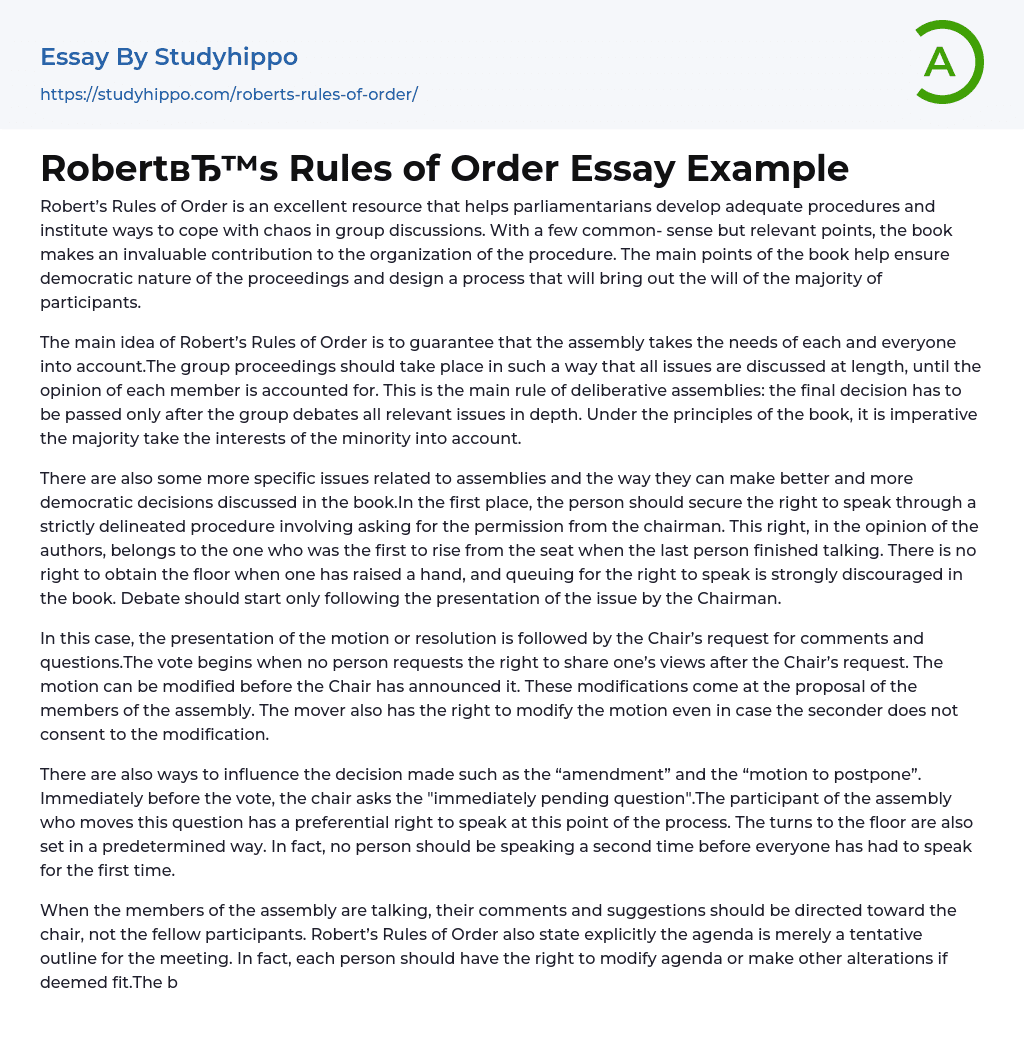Robert’s Rules of Order is an excellent resource that helps parliamentarians develop adequate procedures and institute ways to cope with chaos in group discussions. With a few common- sense but relevant points, the book makes an invaluable contribution to the organization of the procedure. The main points of the book help ensure democratic nature of the proceedings and design a process that will bring out the will of the majority of participants.
The main idea of Robert’s Rules of Order is to guarantee that the assembly takes the needs of each and everyone into account.The group proceedings should take place in such a way that all issues are discussed at length, until the opinion of each member is accounted for. This is the main rule of deliberative assemblies: the final decision has to be passe
...d only after the group debates all relevant issues in depth. Under the principles of the book, it is imperative the majority take the interests of the minority into account.
There are also some more specific issues related to assemblies and the way they can make better and more democratic decisions discussed in the book.In the first place, the person should secure the right to speak through a strictly delineated procedure involving asking for the permission from the chairman. This right, in the opinion of the authors, belongs to the one who was the first to rise from the seat when the last person finished talking. There is no right to obtain the floor when one has raised a hand, and queuing for the right to speak is strongly discouraged in the book. Debate should start only following the presentation o
the issue by the Chairman.
In this case, the presentation of the motion or resolution is followed by the Chair’s request for comments and questions.The vote begins when no person requests the right to share one’s views after the Chair’s request. The motion can be modified before the Chair has announced it. These modifications come at the proposal of the members of the assembly. The mover also has the right to modify the motion even in case the seconder does not consent to the modification.
There are also ways to influence the decision made such as the “amendment” and the “motion to postpone”. Immediately before the vote, the chair asks the "immediately pending question".The participant of the assembly who moves this question has a preferential right to speak at this point of the process. The turns to the floor are also set in a predetermined way. In fact, no person should be speaking a second time before everyone has had to speak for the first time.
When the members of the assembly are talking, their comments and suggestions should be directed toward the chair, not the fellow participants. Robert’s Rules of Order also state explicitly the agenda is merely a tentative outline for the meeting. In fact, each person should have the right to modify agenda or make other alterations if deemed fit.The book has guidelines for a variety of specific occasions.
These guidelines are embodied in specific rules that have distinct names: “Point of Privilege”, “Parliamentary Inquiry”, “Point of Motion”, etc. These rules serve to sort out situations when conflict can potentially arise and come up with adequate solutions. Overall, Robert’s Rules of Order
is a highly effective framework for organized meetings. Initially intended as a set of guidelines for the Parliament’s procedures, it can be adopted at virtually any organization.
This is why a number of groups make use of these rules to make their meetings democratic and more effective.
- Boo Radley essays
- Genesis essays
- Richard iii essays
- Alice in Wonderland essays
- On the road essays
- Ozymandias essays
- The Nightingale essays
- Holden Caulfield essays
- Animal Farm essays
- 1984 essays
- A Hanging essays
- Shooting An Elephant essays
- A Tale Of Two Cities essays
- Adventures Of Huckleberry Finn essays
- Arthur Conan Doyle essays
- Brave New World essays
- Characters In Hamlet essays
- Characters In Romeo And Juliet essays
- Desdemona essays
- Diary Of A Wimpy Kid essays
- First-Person Narrative essays
- Frankenstein essays
- Heart Of Darkness essays
- Jane Eyre essays
- Jay Gatsby essays
- King Duncan essays
- Librarian essays
- Little Red Riding Hood essays
- Lord Of The Flies essays
- Silas Marner essays
- The Cask Of Amontillado essays
- The Catcher In The Rye essays
- The Crucible essays
- The Handmaid's Tale essays
- The Reader essays
- Virgil essays
- Wuthering Heights essays
- Candide essays
- Castle essays
- J. D. Salinger essays
- Ulysses essays
- Ethan Frome essays
- In Cold Blood essays
- Outliers essays
- Tuesdays With Morrie essays
- The Art of War essays
- Wife of Bath essays
- Huckleberry Finn essays
- The Lady With The Dog essays
- Great Expectations essays




